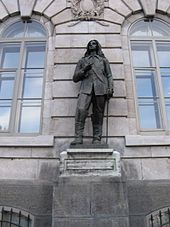|
Pierre Boucher
Pierre Boucher de Boucherville (born Pierre Boucher [pjɛʁ buʃe]; 1 August 1622 – 19 April 1717) was a French settler, soldier, officer, naturalist, official, governor, and ennobled aristocrat in Nouvelle-France or New France (in what is now Canada). Early lifePierre emigrated from France to New France in 1634 with his father, Gaspard Boucher, a carpenter. At the age of 18, he entered the services of the Jesuits and spent four years with the Huron missions at Georgian Bay (see Sainte-Marie among the Hurons). He spoke fluent Iroquoian languages, of which Huron is a dialect. From Corporal to Governor In 1641, Governor Charles Huault de Montmagny took him into his service as a soldier in the garrison of Quebec City, but especially as an interpreter and agent to the Indian tribes due to his familiarity with the Huron dialect. In this capacity, he took part in all the parleys of the authorities with the Indians. In 1645, Boucher was appointed official interpreter of Indian languages at Trois-Rivières. He rose through the ranks first as corporal, sergeant, and then as commissioned officer. He was appointed commissary-general of the trading post in 1648 and elected captain of the militia in 1651. While in this capacity, he distinguished himself against an attack by the Iroquois in 1653 and concluded a peace treaty with them on favourable terms. The next year, owing to this success, he was named governor of the settlement. Raised to nobility In 1661, he was sent to France to represent the colonies. He returned with soldiers, supplies, additional settlers and a commitment of support to the colony of New France by the French king, Louis XIV. Pierre Boucher was the first Canadian settler to be ennobled by King Louis XIV.[1] Re-appointed governorRe-appointed governor in 1662, a position he held until his resignation in 1667. His L'histoire veritable et naturelle des moeurs et productions du pays de la Nouvelle-France, vulgairement dite le Canada, a description of the flora, fauna and native societies in the region (and a significant, pioneering documentation of North American natural history) was published in Paris in 1664. He was succeeded in the governorship by his son-in-law, René Gaultier de Varennes. He withdrew from public office to establish his Seigneurie centred on Boucherville on the south shore of the St Lawrence River near Montreal and extending out well into the Montérégie region. His lands also included parts of the North Shore extending out to la Mauricie and Trois-Rivières. He died at his seigneury at Boucherville, which was named in his honour. FamilyPierre Boucher married Marie-Madeleine Chrestienne (Ouebadinoukoué), a Huron girl who had been educated by the Ursuline order of nuns; she died in childbirth. Their infant son Jacques did not survive. Pierre Boucher later married Jeanne Crevier, who bore 15 children; Their descendants took many names and thrived in the diaspora of New France, and many lines are still in existence today. The eldest son, Pierre Boucher inherited the title and seigneurie of Boucherville, which had excellent land in the alluvial floodplain of the St Lawrence River. He married his eldest daughter, Marie-Ursule Boucher, to René Gaultier de Varennes, governor of Trois Rivières, under whom he had served. It is not known whether Pierre Boucher received land as dowry, as an award of bravery, or during his tenure as governor of Trois Rivières, but later Pierre Boucher the eldest is cited as having a Northern Mauricie holding, having rockier soil, which he split into two fiefdoms for his next two sons: Lambert Boucher De Grandpré and Ignace Boucher De Grosbois. NameWhile first surname of the family is Boucher; this name is gradually supplanted by the names of nobility, which become the new surnames of this diverse genealogical branche. Surnames in the Boucher line include Montarville, or de Montarville, Grandpré, DeGrandpré, or de Grandpré, Grosbois, DeGrosbois or de Grosbois, Des Rochés or DesRocher, Monbrun or de Monbrun, LaPerrière or de la Perrière, LaCoursière or de la Coursière, Montizambert or de Montizambert, Niverville or de Niverville, Bruyère or de la Bruyère, le Clerc, Lussier, Marcotte, Saucier, Gaultier de Varennes, LeGardeur de Tilly, Daneau de Muy, Sabrevois de SermonVille. Descendants have spread beyond Canada to places including the United States, Mauritius, France, Brazil, and the West Indies, and include such prominent French-Canadians and French-Americans as Paul André Albert and Jade Raymond. Issue
Publications
See also
References
External linksWikimedia Commons has media related to Pierre Boucher.
|
||||||||||||||||||||||||||||||||||||
